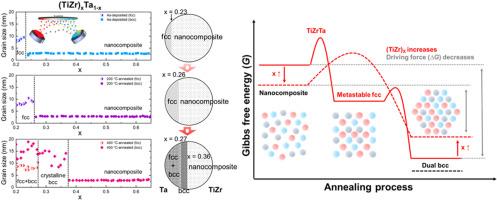用组合文库加速鉴定纳米难熔介质熵合金的显微组织和相稳定性
IF 8.2
2区 材料科学
Q1 MATERIALS SCIENCE, MULTIDISCIPLINARY
引用次数: 0
摘要
纳米结构材料的稳定性对其应用至关重要,特别是在高温下。许多新兴的多组分合金,如中熵合金(MEAs)和高熵合金(HEAs)的复杂性,为从巨大的成分和温度空间中识别稳定的纳米结构合金提出了新的挑战。在此,我们通过组合合成、退火和表征,系统地研究了(TiZr)xTa1−x、(TiZr)xNb1−x和(TiZr)x(NbTa)1−x三个纳米结构的MEA体系,从室温到400℃。与(TiZr)xNb1−x和(TiZr)x(NbTa)1−x呈现出体心立方(bcc)相不同,(TiZr)xTa1−x文库在富ta区呈现出亚稳面心立方(fcc)结构,而在富TiZr区则呈现出由bcc纳米颗粒和非晶态基体组成的纳米复合材料。退火后,高分辨率TEM图像确定这种fcc和纳米复合材料结构转变为完全结晶的bcc相。本研究确定了Nb和Ta对MEAs微观结构和相稳定性的单独和协同效应,为加速发现复杂纳米结构合金以及确定其在大成分和温度尺寸下的稳定性铺平了道路。本文章由计算机程序翻译,如有差异,请以英文原文为准。

Accelerated identification of microstructure and phase stability in nanostructured refractory medium entropy alloys by combinatorial libraries
The stability of nanostructured materials is vital for their applications, particularly at elevated temperatures. The complexity of many emerging multiple-component alloys, such as medium-entropy alloys (MEAs) and high-entropy alloys (HEAs), poses new challenges to identifying stable nanostructured alloys from vast composition and temperature spaces. Here, we have systematically studied three nanostructured MEA systems, (TiZr)xTa1−x, (TiZr)xNb1−x, and (TiZr)x(NbTa)1−x, from room temperature to 400 °C, through combinatorial synthesis, annealing, and characterization. Unlike (TiZr)xNb1−x and (TiZr)x(NbTa)1−x exhibiting crystalline body-centered cubic (bcc) phase, the (TiZr)xTa1−x library shows anomalous phase formation: metastable face-centered cubic (fcc) structure in the Ta-rich region, while a nanocomposite consisting of bcc nano-grains and amorphous matrix in the TiZr-rich region. Upon annealing, high-resolution TEM images determine that such fcc and nanocomposite structures transform into a fully crystalline bcc phase. This study identifies the individual and synergistic effects of Nb and Ta on the microstructure and phase stability of the MEAs, paving the way for the accelerated discovery of complex nanostructured alloys and the identification of their stability in large composition and temperature dimensions.
求助全文
通过发布文献求助,成功后即可免费获取论文全文。
去求助
来源期刊

Materials Today Nano
Multiple-
CiteScore
11.30
自引率
3.90%
发文量
130
审稿时长
31 days
期刊介绍:
Materials Today Nano is a multidisciplinary journal dedicated to nanoscience and nanotechnology. The journal aims to showcase the latest advances in nanoscience and provide a platform for discussing new concepts and applications. With rigorous peer review, rapid decisions, and high visibility, Materials Today Nano offers authors the opportunity to publish comprehensive articles, short communications, and reviews on a wide range of topics in nanoscience. The editors welcome comprehensive articles, short communications and reviews on topics including but not limited to:
Nanoscale synthesis and assembly
Nanoscale characterization
Nanoscale fabrication
Nanoelectronics and molecular electronics
Nanomedicine
Nanomechanics
Nanosensors
Nanophotonics
Nanocomposites
 求助内容:
求助内容: 应助结果提醒方式:
应助结果提醒方式:


